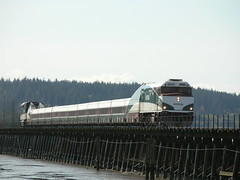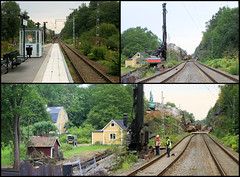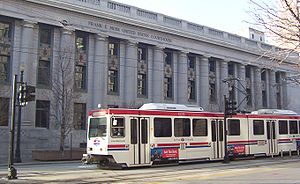 Image by Stephen Rees via Flickr
Image by Stephen Rees via Flickr
A weekly digest of events, opinions, and forecasts from
United Rail Passenger Alliance, Inc.
America’s foremost passenger rail policy institute
1526 University Boulevard, West, PMB 203 • Jacksonville, Florida 32217-2006 USA
Telephone 904-636-7739, Electronic Mail info@unitedrail.org • http://www.unitedrail.org
Volume 6, Number 33
Founded over three decades ago in 1976, URPA is a nationally known policy institute which focuses on solutions and plans for passenger rail systems in North America. Headquartered in Jacksonville, Florida, URPA has professional associates in Minnesota, California, Arizona, New Mexico, the District of Columbia, Texas, New York, and other cities. For more detailed information, along with a variety of position papers and other documents, visit the URPA web site at http://www.unitedrail.org.
URPA is not a membership organization, and does not accept funding from any outside sources.
1) Good ideas never go bad, they just sometimes are put on a shelf.
Over a full decade ago in 1998, the late Adrian Herzog, Ph.D., one of the original bright lights of United Rail Passenger Alliance, compiled a long term plan for the expansion of Amtrak.
Dr. Herzog, who by profession was a rocket scientist and university physics department chair professor, died far too young of a heart attack at his home in Northridge, California in February of 2001 at the age of 52.
Outside of the classroom, Dr. Herzog was a business partner with the late Byron Nordberg, also an original bright light of URPA. Dr. Herzog and retired United States Marine Corps Colonel Nordberg were the proprietors of NHA, Inc., a highly successful rail consulting firm based in Oceanside, California. NHA was the engine which brought the UTDC (now Bombardier) bi-level commuter passenger cars to Southern California for both Metrolink and the Coaster services. A very young Noel Braymer, now editor of the Western Rail Passenger Review and luminary in California passenger rail circles, and also an early associate of URPA, worked with Colonel Nordberg and Dr. Herzog.
The amount of work coming from Dr. Herzog was nearly unparalleled. He was one of the first, using early desktop computers, to create computer modeling for Amtrak passenger trains to measure performance and successfully predict future needs. Much of Dr. Herzog’s work has been featured on URPA’s web site, www.unitedrail.org and remains today as relevant as when it was created. Perhaps one of Dr. Herzog’s greatest accomplishments was the creation of the matrix theory, demonstrating how hubbing and end point connections are critical to the success of any passenger rail system.
2) One of the documents left by the untimely death of Dr. Herzog in this writer’s care was his plan of how a successful Amtrak would look in 2010, based on several presumptions made for 2000. Alas, those presumptions were not to be at that time, but it is fascinating to see Dr. Herzog’s vision for the future of Amtrak.
Dr. Herzog believed passenger rail was viable on three levels: as a carrier of leisure travelers, as a carrier of regional travelers moving about for any number of reasons, and as a carrier of business travelers seeking an efficient way to travel making the best use of their time in trips under five hours. Remember, in 1998 when this plan was conceived, things like Wi-Fi connections were not yet common, laptop computers were still bulky and heavy, and cellular telephones were in use by a far smaller percentage of the population.
Dr. Herzog and Colonel Nordberg also believed in two basic principles. First, every route should have at least three frequencies, and more if viable. One frequency would be as existing, a second frequency would follow six to 12 hours later so every city or town would have service at marketable times, and a third frequency mimicking the old milk run local trains, where every station had a stop. As you look at Dr. Herzog’s plan below, and see a train with a route name such as the North Coast Limited, imagine a flip schedule train such as the Mainstreeter providing the second frequency, and perhaps another named train for the local.
In some instances, the local train may better serve the route by being a series of shorter trains, such as on the Southern Crescent route between Washington, D.C. and New Orleans, where two separate day trains may provide the best level of service versus one longer train, by providing one train operating between Washington, D.C. and Atlanta, and a second day train operating between Atlanta and New Orleans. The first two trains, the Southern Crescent and the (to pick a name) Peach Queen would run the entire route, and the two day trains serve as the “local” option on two separate ends of the route.
Second, they believed passenger train routes did not always have to be in a straight line. They both favored “L” shaped routes where possible, such as taking the Lake Shore Limited from New York City to Chicago, and extending the western terminus of this train south to Memphis, Tennessee to make maximum use of equipment, and build as many city pair combinations as possible into the matrix theory.
Dr. Herzog’s plan focused primarily on a robust long distance network. Some of today’s short distance trains would be replaced by long distance trains (more efficient in many ways), but some regional services as we know them today would continue. Since this was a broad blueprint, many of the minor, regional services were not mentioned, but Dr. Herzog implied each would be retained based on productivity and cost.
3) Here is Dr. Herzog’s plan, with some updates for changes which have taken place in the last 11 years.
[Begin quote]
Strategic Routes for Amtrak
A Planning Document
October 25, 1998 • Updated 2008
Prepared by Dr. Adrian Herzog, URPA • Northridge, California
Strategic Goal: Output equal to five times the revenue passenger miles produced in FY 2000, achieved by Year 7 of the strategic plan.
This document was originally prepared by the late Adrian Herzog, Ph.D. in October 1998, and updated a decade later in 2008. The breadth of the document demonstrates the foresight of Dr. Herzog in his quest to make passenger rail in his adopted country subsidy-free.
The planning concepts for this document came from several sources, including historic successful passenger train routes and connectivity points, current travel patterns in the United States for both leisure and business travel, and travel to and from major vacation destinations. As an example, more travelers come to New Orleans from Houston, Texas than any other location.
Other factors taken into consideration are population shifts and population growth in new areas, military installations, and locations of major colleges and universities. Additional factors, such as cruise ship terminals were also considered.
Tactical Goal: Maximize network density of flow by maximizing route inter-connectivity, and multiple frequency (2 to 4) trains per route, per day.
National Corridors
• Southern Transcontinental Corridor
• Southwest Transcontinental Corridor
• Central Transcontinental Corridor
• Northern Transcontinental Corridor
• Atlantic Coast Corridor
• Pacific Coast Corridor
• Southwest Corridor
• Central California Corridor
• Pacific Northwest Corridor
• Chicago-Midwest Corridors
• Florida Corridor
• Gulf Coast Corridor
• Texas Triangle
• International links to Canada and Mexico
• Northeast Corridor low level long distance trains
Equipment Types
• Superliner Service
• California Car Service — Use of the successful daylight California Car/Superliner compatible bi-level equipment for non-overnight trains
• Talgo Service
• Viewliner Service — Conversion of existing fleet single level cars. This Includes: Viewliner, Amfleet, and Horizon
Power Types
• Genesis (Long distance trains)
• F59PH (Corridors)
• AEM-7 (NEC Long distance trains)
Crew Bases
• Seattle
• San Jose
• Los Angeles
• San Diego
• Denver
• Fort Worth
• Chicago
• New Orleans
• Tampa
• Sanford (Auto Train T&E only)
• Miami
• Charlotte
• Newport News
• Norfolk
• Philadelphia
• Boston
• Vancouver/VIA Rail Canada
Maintenance Bases and Principal Commissaries
• Vancouver, British Columbia/VIA Rail Canada
• Seattle
• Eugene, Oregon
• San Jose
• Los Angeles
• San Diego
• Denver
• Fort Worth
• Chicago
• New Orleans
• Tampa
• Sanford (Auto Train/racks only)
• Miami
• Charlotte
• Newport News
• Philadelphia
• Boston
Turn Maintenance and Commissary Support
• Vancouver, British Columbia/VIA Rail Canada
• Toronto/VIA Rail Canada
• Montreal/VIA Rail Canada
• Boston
• Washington
• Lorton
• Newport News
• Norfolk
• Cleveland
• Detroit
• Chicago
• Eugene, Oregon
• Seattle
• San Francisco
• Lancaster, California
• Redding, California
• Reno
• Santa Barbara
• Las Vegas
• Nogales
• Duluth
• Kansas City
• St. Louis
• Memphis
• Birmingham
• Charleston, South Carolina
Southern Transcontinental Corridor
Sunset Limited – Los Angeles, Tucson, El Paso, San Antonio, Houston, New Orleans, Jacksonville Orlando, Tampa
Superliner Service
Golden State – Los Angeles, Phoenix, Tucson, El Paso, Abilene, Fort Worth, Dallas, St. Louis, Chicago, Detroit, Toronto
Superliner Service
Southern Crescent – New Orleans, Atlanta, Washington, DC
Superliner Service
Gulf Breeze – New Orleans, Mobile, Montgomery, Birmingham, Atlanta, Washington, DC, Philadelphia, New York, Boston
Viewliner Service
Gulf Wind – Houston, New Orleans, Mobile, Pensacola, Tallahassee, Jacksonville, Orlando, Tampa
Superliner Service
Continental – Los Angeles, Phoenix, Tucson, El Paso, Abilene, Fort Worth, Dallas, Atlanta, Washington, DC
Superliner Service
Southwest Transcontinental Corridor
Southwest Chief/Capitol Limited – Los Angeles, Albuquerque, Kansas City, Chicago, Pittsburgh, Washington DC, Newport News
Superliner Service
San Francisco Chief – San Jose, Oakland, Bakersfield, Albuquerque, Kansas City, St. Louis, Chicago
Superliner Service
Grand Canyon Limited – Los Angeles, Albuquerque, Denver
Superliner Service
Zia – Denver, Albuquerque, Las Cruces, El Paso
Superliner Service
El Capitan – Chicago, Kansas City, Flagstaff, Phoenix, Tucson
Superliner Service
Central Transcontinental Corridor
California Zephyr – Los Angeles, San Jose, Oakland, Reno, Salt Lake City, Provo, Denver, Chicago
Superliner Service
Overland Limited – Los Angeles, Las Vegas, Provo, Salt Lake City, Ogden, Laramie, Denver, Omaha, Chicago, Cleveland, Boston
Superliner Service
Pioneer Zephyr – Vancouver BC, Seattle, Portland, Ogden, Salt Lake City, Provo, Denver, Newton, Oklahoma City, Fort Worth, Dallas, Houston, New Orleans
Superliner Service
George Washington – Kansas City, St. Louis, Louisville, Cincinnati, Charleston WV, Charlottesville, Richmond, Newport News
Superliner Service
Cavalier – Fort Worth, Dallas, Little Rock, Memphis, Chattanooga, Knoxville, Roanoke, Lynchburg, Charlottesville, Washington
Superliner Service
The Memphian – Fort Worth, Dallas, Little Rock, Memphis, Nashville, Louisville, Cincinnati, Charleston WV, Charlottesville, Richmond, Newport News
Superliner Service
Northern Transcontinental Corridor
Empire Builder – Vancouver BC, Seattle, Yakima, Spokane, Minneapolis, Chicago, Indianapolis, Cincinnati, Newport News
Superliner Service
North Coast Limited – Seattle, Spokane, Missoula, Butte, Bozeman, Billings, Bismarck, Minneapolis, Chicago
Superliner Service
Hiawatha – Eugene, Portland, Spokane, Minneapolis, Chicago
Superliner Service
Broadway Limited/Three Rivers – Duluth, Minneapolis, Chicago, Cleveland, Pittsburgh, Philadelphia, New York, Boston
Viewliner Service
Pennsylvanian – Kansas City, Chicago, Pittsburgh, Harrisburg, Philadelphia
Viewliner Service
New England States – St. Louis, Chicago, Toledo, Cleveland, Buffalo, Albany, Springfield, Boston
Viewliner Service
Pacemaker – Chicago, Toledo, Cleveland, Buffalo, Albany, New York, Philadelphia
Viewliner Service
Lake Shore Limited – Memphis, Chicago, Toledo, Cleveland, Buffalo, Albany, New York, Boston
Viewliner Service
Steeler – St. Louis, Indianapolis, Pittsburgh, Harrisburg, Philadelphia
Viewliner Service; Crew Base: Philadelphia
Columbian – Denver, Chicago, Cleveland, Pittsburgh, Washington DC, Newport News
Viewliner Service
Oriental – Vancouver BC, Edmonton, Winnipeg, Minneapolis, Chicago, Detroit, Toronto (Seasonal)
Viewliner Service
Atlantic Seaboard Corridor
Silver Meteor – Miami, Orlando, Jacksonville, Charleston, Rocky Mount, Richmond, Washington, Philadelphia, New York, St. Albans, Montreal
Viewliner Service
Silver Star – Miami, Ocala, Jacksonville, Columbia, Raleigh, Richmond, Washington, Philadelphia, New York, Boston
Viewliner Service
The Sunland – Tampa, Orlando, Jacksonville, Columbia, Raleigh, Richmond, Washington, Philadelphia, New York, Boston
Viewliner Service
Everglades – Miami, Daytona Beach, Jacksonville, Columbia, Raleigh, Richmond, Washington, Philadelphia, New York, Buffalo, Toronto
Viewliner Service
Auto Train, (Passenger section) – Tampa, Orlando, Sanford, Jacksonville, Savannah, Charleston, Rocky Mount, Richmond, Lorton, Washington, Pittsburgh, Cleveland (All station stops)
Superliner Service
Auto Train, (Car carrier section) – Sanford, Lorton
City of New Orleans – Tampa, Orlando, Jacksonville, Mobile, New Orleans, Chicago, Detroit, Toronto
Superliner Service
City of Miami – Miami, Orlando, Jacksonville, Charleston SC, Rocky Mount, Richmond, Charlottesville, Charleston WV, Cincinnati, Indianapolis, Chicago
Superliner Service
Flamingo – Tampa, Orlando, Jacksonville, Savannah, Macon, Atlanta
California Car Service
Silver Comet – Miami, West Palm Beach, Daytona Beach, Jacksonville, Savannah, Macon. Atlanta, Birmingham
Superliner Service
The Resort Special – Miami, West Palm Beach, Daytona Beach, Jacksonville, Savannah, Columbia, Raleigh, Richmond, Washington, Philadelphia, New York, Boston
Viewliner Service
Champion – Miami, West Palm Beach, Daytona Beach, Jacksonville, Savannah, Charleston, Rocky Mount, Richmond, Washington, Philadelphia, New York, Long Island
Viewliner Service
Gulf Coast Special – Tampa, Orlando, Jacksonville, Savannah, Charleston, Rocky Mount, Richmond, Washington, Philadelphia, New York, Long Island
Tidewater – Charleston, Florence, Fayetteville, Rocky Mount, Franklin, Suffolk, Norfolk
California Car Service
Piedmont – Charlotte, Raleigh, Rocky Mount, Franklin, Suffolk, Norfolk
California Car Service
Southern States – Tampa, Ocala, Jacksonville, Savannah, Columbia, Hamlet, Charlotte
California Car Service
Palmland – Miami, West Palm Beach, Orlando, Jacksonville, Savannah, Columbia, Hamlet, Charlotte, High Point, Greensboro, Danville, Charlottesville, Washington, Philadelphia, New York, Boston
Viewliner Service
Rue Orleans – New Orleans, Mobile, Montgomery, Birmingham, Nashville, Louisville, Cincinnati, Columbus, Cleveland, Buffalo, Syracuse, Montreal
Superliner Service
Southwind – Miami, Orlando, Jacksonville, Savannah, Columbia, Raleigh, Richmond, Washington, Pittsburgh, Cleveland, Toledo, Detroit
Superliner Service
Pacific Coast Corridor
Coast Starlight – Los Angeles, San Jose, Oakland, Sacramento, Eugene, Portland, Seattle
Superliner Service
Shasta Daylight – Los Angeles, Bakersfield, Fresno, Sacramento, Eugene, Portland, Seattle, Vancouver BC
Superliner Service
Columbia Starlight – Los Angeles, Las Vegas, Provo, Salt Lake, Ogden, Pocatello, Portland, Seattle
Superliner Service
Southwest Corridor
Pacific Surfliners – San Diego, Los Angeles, Santa Barbara, San Jose, San Francisco
Joint Talgo and California Car Service
High Desert – San Diego, Los Angeles, Palmdale, Lancaster
California Car Service
Las Vegans/South – San Diego, Santa Ana, Riverside, San Bernardino, Barstow, Las Vegas
Talgo Service
Las Vegans/North – Santa Barbara, Los Angeles, El Monte, San Bernardino, Las Vegas
Talgo Service
Arizonan – Los Angeles, Riverside, Palm Springs, Indio, Yuma, Phoenix, Tucson, Nogales
Talgo Service
Grand Canyon – Nogales, Tucson, Phoenix, Williams Junction, Grand Canyon
Talgo Service
Central California Corridor
San Joaquins I – San Jose, Oakland, Fresno, Bakersfield, San Bernardino, Santa Ana, San Diego
California Car Service
San Joaquins II – Bakersfield, Fresno, Sacramento, Redding
California Car Service
Capitols – San Jose, Oakland, Sacramento, Reno
Joint Talgo and California Car Service
Pacific Northwest Corridor
Cascades — Eugene, Portland, Seattle, Vancouver BC
Talgo Service
Chicago-Midwest Corridors
Train of the Saints — St. Paul (Minneapolis), La Crosse, Galesburg, Fort Madison, St. Louis
California Car Service
The Motor City — Kansas City, St. Louis, Chicago, Detroit
California Car Service
The Midwesterner — Omaha, Chicago, Cleveland
California Car Service
The Brewer — Minneapolis, Milwaukee, Chicago, Detroit
California Car Service
The City of Nashville — Chicago, Indianapolis, Louisville, Nashville
California Car Service
Florida Corridor
Seminole – Pensacola, Tallahassee, Jacksonville
California Car Service
Tampa Bay – Jacksonville, Orlando, Tampa
California Car Service
Henry Flagler – Jacksonville, Daytona Beach, West Palm Beach, Miami
California Car Service
Citrus State – Jacksonville, Ocala, West Palm Beach, Miami
California Car Service
Florida Palm – Tampa, West Palm Beach, Miami
California Car Service
Gulf Coast Corridor
Gulf Coast Limited – Houston, New Orleans, Mobile
California Car Service
Iron Mountain – New Orleans, Mobile, Montgomery, Birmingham
California Car Service
Louisiana Eagle – New Orleans, Baton Rouge, Shreveport, Dallas, Fort Worth
California Car Service
Texas Triangle
Texan – Dallas, Fort Worth, Austin, San Antonio, Houston, Dallas
California Car Service
Northeast Corridor (Extended Service Area, in addition to NEC Acela and Regional Service)
Mid Atlantic – Pittsburgh, Philadelphia, Baltimore, Washington DC, Richmond, Newport News (Viewliner Service)
Maple Leaf/Montrealer – Boston, Albany, Toronto, and New York, Albany, Montreal (Cross Platform at Albany)
Viewliner Service
Royal Blue – Newport News, Washington DC, Baltimore, Philadelphia, New York, Long Island (Viewliner Service)
Bostonian – Boston, New York, Allentown, Harrisburg
Viewliner Service
Shenandoan – Boston, New York, Philadelphia, Washington, Charlottesville, Cincinnati Viewliner Service
∙ Note: (Viewliner Service) implies any low level conventional long distance and intermediate distance trains including Amfleet, Horizon, and Viewliner
[End quote]
If you are reading someone else’s copy of This Week at Amtrak, you can receive your own free copy each edition by sending your e-mail address to
freetwa@unitedrail.org
You MUST include your name, preferred e-mail address, and city and state where you live. If you have filters or firewalls placed on your Internet connection, set your e-mail to receive incoming mail from twa@unitedrail.org; we are unable to go through any approvals processes for individuals. This mailing list is kept strictly confidential and is not shared or used for any purposes other than distribution of This Week at Amtrak or related URPA materials.
All other correspondence, including requests to unsubscribe should be addressed to
brucerichardson@unitedrail.org
Copies of This Week at Amtrak are archived on URPA’s web site, www.unitedrail.org and also on www.todaywithjb.blogspot.com where other rail-related writings of Bruce Richardson may also be found.
URPA leadership members are available for speaking engagements.
J. Bruce Richardson
President
United Rail Passenger Alliance, Inc.
1526 University Boulevard, West, PMB 203
Jacksonville, Florida 32217-2006 USA
Telephone 904-636-7739
brucerichardson@unitedrail.org
http://www.unitedrail.org
![Reblog this post [with Zemanta]](http://img.zemanta.com/reblog_e.png?x-id=116d228f-3772-4a70-95e4-eedac1c456f5)

![Reblog this post [with Zemanta]](http://img.zemanta.com/reblog_e.png?x-id=d8c223fd-a3d5-4e42-ab11-c84a8494f562)

![Reblog this post [with Zemanta]](http://img.zemanta.com/reblog_e.png?x-id=59036fee-b823-4963-889d-3d354c111223)

![Reblog this post [with Zemanta]](http://img.zemanta.com/reblog_e.png?x-id=720a4a21-052a-4a9f-9463-64b6a4231052)

![Reblog this post [with Zemanta]](http://img.zemanta.com/reblog_e.png?x-id=324e9e3c-8752-412d-a602-64a6167fbd10)

![Reblog this post [with Zemanta]](http://img.zemanta.com/reblog_e.png?x-id=f90ea5d7-7e13-4eb2-9a8c-0186aa6c2e01)

![Reblog this post [with Zemanta]](http://img.zemanta.com/reblog_e.png?x-id=742da3cd-0ad1-4ff7-bb0d-bf2aa33ec000)

![Reblog this post [with Zemanta]](http://img.zemanta.com/reblog_e.png?x-id=acd830e1-f414-4f6f-a2b2-c6ecc727fd56)

![Reblog this post [with Zemanta]](http://img.zemanta.com/reblog_e.png?x-id=a500e867-b193-4cd0-8132-3a2331edc6d6)

![Reblog this post [with Zemanta]](http://img.zemanta.com/reblog_e.png?x-id=b4c81f0f-0d2c-4b1f-8341-7c5de4a9445f)